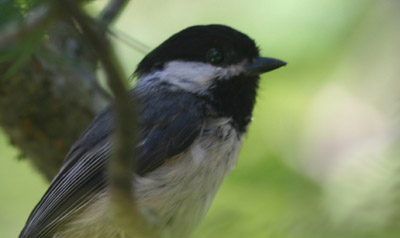Loons may be the birds that first come to mind when one thinks of Maine, but the Black-capped Chickadee holds state bird honors for a reason. Chickadees were among the few species that could be located with regularity, as were Common Ravens. While both American and Fish Crows appeared every now and again, ravens made their raucous, carousing presence known everywhere during our travels around the various coastal towns, from Castine to Stonington to Blue Hill. Watching these bright black birds pick apples off a tree right outside our house was a blast.

Black-capped Chickadee
Besides chickadees and ravens, the DownEast coastal region is great for goldfinch and gulls. In August, Ring-billed Gulls seemed most common, with Herring coming in a close second. Bonaparte’s and Great Black-backed rounded out the quartet of surefire seabirds. The only other species one would be hard pressed to miss at the shore were Double-crested Cormorant and Osprey. Red-tailed Hawks and Turkey Vultures were much less common in Maine than in most other areas of the U.S., so mighty fish hawks assumed most of the soaring gracefully and circling menacingly duties. I don’t mind saying that they did a fabulous job too. Besides these birds, the only raptor I identified conclusively was a Broad-winged Hawk hunting a meadow. A few undifferentiated falcons also turned up, but none of the eagles reputed to nest in the area did.
My high hopes of grouse, owls, and whippoorwills went unrealized, but the woods did hold some pleasant surprises. For example, Black-throated Green Warblers were fairly common. Other infrequent warblers included Yellow-rumped, Hooded, and Ovenbird. The songbirds were slim pickings after black-throated greens and chickadees, but I did spot the occasional Ruby-throated Hummingbird, Red-eyed Vireo, Eastern Phoebe, Eastern Wood-pewee, Gray Catbird, Northern Mockingbird, Cedar Waxwing, Blue Jay, Mourning Dove, Golden-crowned Kinglet, and Winter Wren. I also observed both nuthatches along with Brown Creeper and Downy and Pileated Woodpeckers. Such sparrows as Song, Chipping, and White-throated were in attendance as well as were Dark-eyed Juncos. House Sparrows could be found too, often in the company of Rock Pigeons, their plump partners in invasive activity. However, Maine may well lie above the northern limit of starling endurance, as I saw nary a one around the coast. Global warming should take care of that soon enough.
I should point out that most of the birds listed above appeared infrequently and in small numbers. Maine’s vaunted avian abundance was evident until about 8:00 AM each day; after that, a birder is forced to work for his bread. The upside is that many of the birds spotted this time of year are juveniles, harder to ID, yes, but their unusual plumage and awkward behavior make up for it.
I should also mention one local specialty that can be spotted just about everywhere along the coast, assuming one is scanning the bays. We saw out first Black Guillemots off Deer Isle, a flock of four sleek black birds with neat white wings. More turned up, adults and immatures, as we visited the area’s quaint towns and fishing villages. If you need black guillemot for your life list, or simply want to see a spectacularly attractive alcid without leaving land, DownEast Acadia is a lock.













Leave a Comment